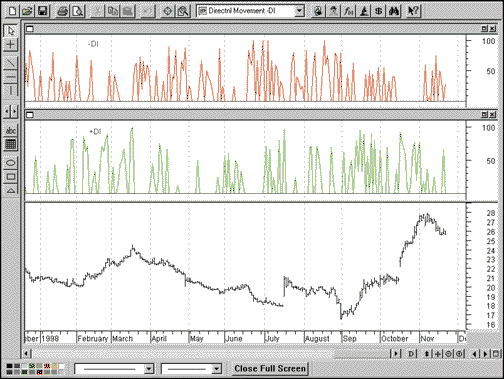Most technical trading methods can be categorized into one of two types: Trend-following, which involves taking trades with the trend, or range trading, which involves looking for reversal points in a trading range. Traders need to determine if the stock they are trading is trending or in a trading range. The fact is, a system is specifically designed for a particular type of market condition, such as trend-following, and is not profitable when a market is in another type of market condition, as in a range. In such cases, a trading range indicator, such as one that indicates overbought and oversold conditions, will put you on the wrong side of a strong trend. Individual indicators also exhibit this characteristic.
INDICATORS
Directional Movement
by Stuart Evens
There's no way around it: Traders trade the trend, be it short term or long term. It follows, then, that there is a need to identify when a market is trending. Here's J. Welles Wilder's directional movement, a set of technical indicators designed to recognize trending markets.

For example, some indicators like the moving average convergence/divergence (MACD) work well when the stock is in a trend but then will give false signals when it is in a trading range. Other indicators, like the stochastic oscillator, work well when the stock trades in a range but it can give premature overbought or oversold signals in a trending market. Relying on indicators or trading methods in the wrong market conditions can cause painful losses.FIGURE 1: DIRECTIONAL MOVEMENT FOR IBP. Each of the directional indicators for IBP can be seen here in separate windows. The -DI is in the top window, the +DI is in the middle window, and price bars are plotted in the lower window. Both indicators are steep and erratic compared with the stock price.
A way to avoid this would be to determine the type of market that a tradable is in and then use appropriate indicators or trading methods. With that in mind, it's not surprising that systems have been developed to recognize when markets shift from a trading range to trending, and then signal long and short positions based on the indicated trend direction. One of these systems, developed by J. Welles Wilder Jr. and described in his book, New Concepts In Technical Trading Systems, is known as directional movement.
Wilder developed this system as a standalone trading method for catching a trend as well as a screening method for determining when to use trending versus nontrending systems. The principles described by Wilder can be used alone or combined with other indicators to develop your own trading system. To better understand this system and how it can be used to identify trending stocks, let us examine the directional movement system.
ON DIRECTIONAL MOVEMENT
Directional movement is available in many technical analysis software packages, and it can also be calculated using spreadsheet software, such as Excel (see sidebar, "The ADX"). The directional movement indicators are plotted as lines, and their relative values and slopes determine if the stock is trending. The system also identifies the trend direction and signals the entry into the position after the move has begun; the exit from the position is signaled when directional movement indicates the trend is ending. This system will not have you in the stock at the very bottom, nor out at the very top. The aim is to have you profit from the middle of a reasonably strong trend. Let's look at the steps taken to reach this goal.
The first step in this process is to compare today's range of price movement with that of yesterday and determine the relative direction. Many relationships are possible between today's and yesterday's range of prices, but all are classified as one of three net directional movements: positive (+DM), negative (-DM), or none (see sidebar Figure 1).